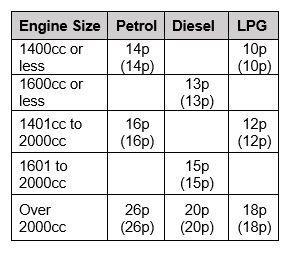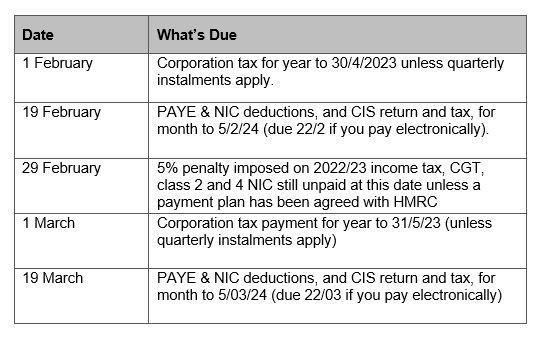Tax Tips for February 2024
YEAR END TAX PLANNING
It’s not too late to undertake some end of year tax planning. If you have some spare cash, an obvious tax planning point would be to maximise your ISA allowances for the 2023/24 tax year (currently £20,000 each). You might also want to consider increasing your pension savings before 5 April 2024.

USE A LIFETIME ISA (LISA) TO SAVE FOR YOUR FIRST HOME
Those aged between 18 and 40 can set up a Lifetime ISA (Individual Savings Account) to buy their first home or save for later life. You can put in up to £4,000 each year until you’re 50. The government will add a 25% bonus to your savings, up to a maximum of £1,000 per year. Note that the Lifetime ISA limit of £4,000 counts towards your £20,000 annual ISA limit.
You can withdraw money from your ISA if you’re:
buying your first home, aged 60 or over, or terminally ill, with less than 12 months to live.
However, you’ll pay a withdrawal charge of 25% if you withdraw cash or assets for any other reason (an unauthorised withdrawal). This recovers the government bonus you received on your original savings.
PENSION PLANNING
Under the current rules, the government adds to your pension contributions at the 20% basic rate. For instance, if you save £4,000 in a personal pension, the government tops this up to £5,000. If you are a higher rate taxpayer there is a further £1,000 tax relief when your tax liability is calculated, reducing the net cost to £3,000.
Additional pension contributions can be even more effective if your income is between £100,000 and £125,140 as the gross pension contribution reduces net income for the purposes of the reduction in the personal allowance. Note that for every £2 of income in excess of £100,000, the £12,570 personal allowance is reduced by £1, with reduction to nil where net income is £125,140 or more. This is effectively a 60% tax saving.
CAPITAL GAINS TAX PLANNING
You might wish to consider bringing forward capital gains to before 6 April 2024 where you haven’t used your £6,000 CGT annual exemption. This exempt amount reduces to just £3,000 for gains made in 2024/25.
CAPITAL EXPENDITURE PLANNING
Unless the business year end is 31 March or 5 April, the end of the tax year is not a significant date as far as capital allowances are concerned. In order for new equipment to attract capital allowances, the expenditure must be incurred on or before the end of the accounting period. Limited companies buying new (not second hand) equipment are entitled to fully expense the cost of most acquisitions against business profits. There is no financial limit on expenditure qualifying for this “full expensing” relief.
Unincorporated businesses are entitled to 100% write off for the first £1 million spent on new and used equipment in a 12 month period. This “annual investment allowance” (AIA) is also available to limited companies buying second hand equipment. The AIA does not apply to motor cars but there is a special 100% tax relief if you buy a new zero-emissions motor car.
Where equipment is bought under a hire purchase contract, the capital allowances outlined above are available on the full cost of the asset provided it has been brought into use by the end of the accounting period. This is despite the fact that the payments may be spread over a number of months.
GET READY FOR MORE R&D CHANGES
On top of the major changes to research and development (R&D) tax relief that took effect from 1 April 2023, there are yet more changes that take effect from 1 April 2024.
The main change from 1 April 2024 is that most companies carrying out qualifying R&D will be entitled to a 20% expenditure credit. The 20% is calculated on the amount of qualifying expenditure. Qualifying expenditure is extended to include subsidised expenditure from 1 April 2024, although R&D carried out overseas will no longer qualify unless the work cannot be undertaken in the UK.
“R&D intensive” companies that make trading losses will continue to be entitled to a tax refund instead of the expenditure credit. The definition of “R&D intensive” is reduced from 40% to 30% from 1 April 2024, which means a company that spends at least 30% of total expenditure on qualifying R&D.
R&D tax relief continues to be a complex area and we can work with you to help you prepare a valid claim.
ADVISORY FUEL RATE FOR COMPANY CARS
The table below sets out the HMRC advisory fuel rates from 1 March 2024. These are the suggested reimbursement rates for employees' private mileage using their company car.
Where the employer does not pay for any fuel for the company car, these are the amounts that can be reimbursed in respect of business journeys without the amount being taxable on the employee. Where there has been a change the previous rate is shown in brackets. You can also continue to use the previous rates for up to 1 month from the date the new rates apply.
Note that for hybrid cars you must use the petrol or diesel rate.
For fully electric vehicles the rate is 9p per mile.

DON’T BE LATE IN PAYING YOUR PERSONAL TAX BILL
2022/23 income tax, CGT, class 2 and 4 NIC liabilities should have been paid by 31 January 2024 unless you have agreed a payment plan with HMRC. Note that if the balance is still unpaid at the end of February 2024, a 5% surcharge penalty is added in addition to the normal interest charge unless a payment plan has been agreed.
DIARY OF MAIN TAX EVENTS FEB/MAR 2024




